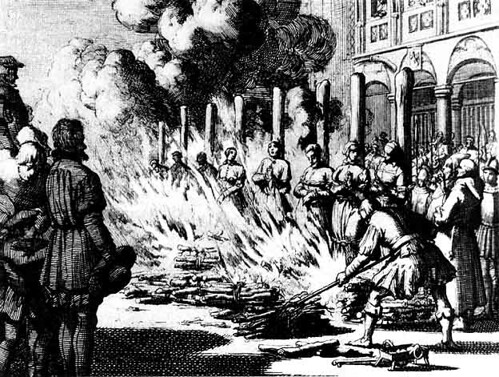
Get THIS:
On December 5, 1484, Pope Innocent VIII issued the Summis desiderantes affectibus, a papal bull in which he recognized the existence of witches and gave full papal approval for the inquisition to move against witches, including the permission to do whatever necessary to get rid of them. In the bull, which is sometimes referred to as the "Witch-Bull of 1484", the witches were explicitly accused of having "slain infants yet in the mother's womb" (abortion) and of "hindering men from performing the sexual act (control over women's sexuality) and women from conceiving" (contraception).
-Wikipedia, Witch trials in Early Modern Europe
Women have always been healers, and medicine has always been an arena of struggle between female practitioners and male professionals. This pamphlet explores two important phases in the male takeover of health care: the suppression of witches in medieval Europe and the rise of the male medical profession in the United States. The authors conclude that despite efforts to exclude them, the resurgence of women as healers should be a long-range goal of the women’s movement.
In the sixteenth century, a rise in sexual violence in European society was exacerbated by pressure from church and state to change basic sexual customs...As the centuries since have shown escalating levels both of violence, general and sexual, and of state control, the witchcraze can be considered a portent, even a model, of some aspects of what modern Europe would be like."
Over three centuries, approximately one hundred thousand persons, most of whom were women, were put to death under the guise of "witch hunts", particularly in Reformation Europe. The shocking annihilation of women from all walks of life is explored in this brilliant, authoritative feminist history Anne Llwellyn Barstow. Barstow exposes an unrecognized holocaust -- the "ethnic cleansing" of independent women in Reformation Europe -- and examines the residual attitudes that continue to influence our culture.
Barstow argues that it is only with eyes sensitive to gender issues that we can discern what really happened in the persecution and murder of these women. Her sweeping chronicle examines the scapegoating of women from the ills of society, investigates how their subjugation to sexual violence and death sent a message of control to all women, and compares this persecution of women with the enslavement and slaughter of African slaves and Native Americans.
Ultimately Barstow traces the current backlash against women to its gynophobic torture-filled origins. In the process, she leaves an indelible mark on our growing understanding of the legacy of violence against women around the world.

No comments:
Post a Comment